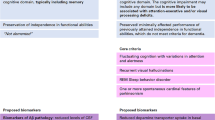Abstract
The proposal of cholinomimetic treatment as a rational basis for the therapy of Alzheimer's disease has been prematurely dismissed by some workers on the hypothesis of impaired coupling/signal transduction of postsynaptic cholinergic receptors. Disparity of reports studying such impairment may be due to inappropriate extrapolation of experimental systems to the physiological stituation, as well as inadequate consideration of disease epiphenoma. In the present study we have used samples with short duration of terminal coma, collected using techniques to minimise postmortem autolysis, and samples obtained during neurosurgery to examine carbachol stimulated hydrolysis of [3H]phosphatidylinositol (PI) as a marker for receptor/signal transduction integrity. The influence of postmortem delay was also studied using another series of samples and a rat model. While a significant correlation of postmortem delay and carbachol stimulated [3H]PI hydrolysis was found, comparison of pooled neurosurgical and postmortem controls with AD samples revealed no significant reduction. Thus this study concurs with a similar one previously reported here, using [3H]phosphatidylinositol 4,5-bisphosphate (1). They provide evidence for competent receptor-signal transduction events in AD, supporting the use of cholinomimetic therapy for disease treatment.
Similar content being viewed by others
References
Wallace, M. A., and Claro, E. 1993. Transmembrane signalling through phospholipase C in human cortical membranes. Neurochem. Res. 18:139–145.
Byrne, E., and Arie, T. 1994. Tetrahydroaminoacridine and Alzheimer's disease. Br. Med. J. 308:868–869.
Jope, R. S., Song, L., Li, X., and Powers, R. 1994. Impaired phosphoinositide hydrolysis in Alzheimer's disease brain. Neurobiol. Aging 15:221–226.
Procter, A. W., Francis, P. T., Holmes, C., Webster, M.-T., Qume, M., Stratmann, G. C., Doshi, R., Mann, D. M. A., Harrison, P. J., Pearson, R. C. A., and Bowen, D. M. 1994. APP isoforms show correlations with neurones but not with glia in brains of demented subjects. Acta Neuropathol. 88:545–552.
Procter, A. W., Stratmann, G. C., Francis, P. T., Lowe, S. L., Benolucci, P. H. F., and Bowen, D. M. 1991. Characterisation of the glycine modulatory site of the N-methyl-D-aspartate receptor-morophore complex in human brain. J. Neurochem. 56:299–310.
Claro, E., Wallace, M. A., Lee, H.-M., and Fain, J. N. 1989. Carbachol in presence of GTPγ stimulates the breakdown of exogenous phosphatidylinositol 4,5-bisphosphate, phosphatidylinositol 4-phosphate and phosphatidylinositol by rat brain membranes. J. Biol. Chem. 264:18288–18295.
Jope, R. S., Song, L., and Powers, R. 1994. Agonist-induced, GTP-dependent phosphoinositide hydrolysis in postmortem human brain membranes. J. Neurochem. 62:1–7.
Smith, C. J., Perry, E. K., Perry, R. H., Fairbairn, A. F., and Birdsall, N. J. M. 1987. Guanine nucleotide modulation of muscarinic cholinergic receptor binding in postmortem human brain—a preliminary study in Alzheimer's disease. Neurosci. Lett. 82:227–232.
Flynn, D. D., Weinstein, D. A., and Mash, D. C. 1991. Loss of high-affinity agonist binding to M1 muscarinic receptors in Alzheimer's disease: implications for the failure of cholinergic replacement therapies. Ann. Neurol. 29:256–262.
Pearce, B. D., and Potter, L. T. 1991. Coupling of ml muscarinic receptors to G protein in Alzheimer disease. Alzheimer. Dis. Assoc. Disord. 5:163–172.
Chessell, I. P., Francis, P. T., Pangalos, M. N., Pearson, R. C. A., and Bowen, D. M. 1993. Localisation of muscarinic (mi) and other neurotransmitter receptors on corticofugal-projecting pyramidal neurones. Brain Res. 632:86–94.
Wilson, K., Bowen, D. M., Francis, P. T., and Tyrrell, P. 1991. Effect of central cholinergic stimulation on regional cerebral blood flow in Alzheimer's disease. Br. J. Psychiat. 158:538–562.
Gustafson, L., Edvinsson, L., Dahlgren, N., Hagbeg, B., Risberg, J., Rosen, I., and Ferno, H. 1987. Intravenous physostigmine treatment of Alzheimer's disease evaluated by psychometric testing, regional cerebral blood flow (rCBF) measurement, and EEG. Psychopharmacology 93:31–35.
Geaney, D. P., Soper, N., Sheptone, B. J., and Cowen, P. J. 1990. Effect of central cholinergic stimulation on regional cerebral blood flow in Alzheimer's disease. Lancet 335:1484–1487.
Hunter, R., Wyper, D. J., Patterson, J., Hansen, M. T., and Goodwin, G. M. 1991. Cerebral pharmacodynamics of physostigmine in Alzheimer's disease investigated using single-photon computerised tomography. Br. J. Psychiat. 158:351–357.
Minthon, L., Gustafson, L., Dalfelt, G., Hagberg, B., Nilsson, K., Risberg, J., Rosen, I., Seiving, B., and Wendt, P. E. 1993. Oral tetrahydroaminoacridine treatment of Alzheimer's disease evaluated clinically and by regional cerebral blood flow and EEG. Dementia 4:32–42.
Author information
Authors and Affiliations
Rights and permissions
About this article
Cite this article
Alder, J.T., Chessell, I.P. & Bowen, D.M. A neurochemical approach for studying response to acetylcholine in Alzheimer's disease. Neurochem Res 20, 769–771 (1995). https://doi.org/10.1007/BF00969687
Accepted:
Issue Date:
DOI: https://doi.org/10.1007/BF00969687




